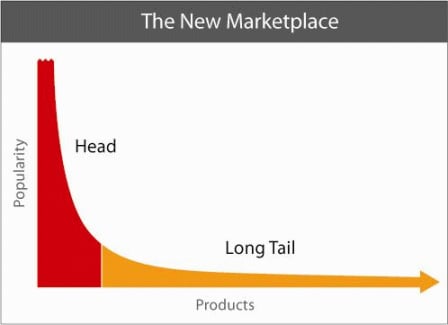Economy Of Scale – Long Tail Fails For Music
Chris Anderson’s Long Tail theory is one of the most popular conceptual memes of Web 2.0. Despite its prevalence and obvious appeal, a recent study of digital music sales claims that this model may not be the salvation of the industry after all…
Tall Tales Of The Long Tail
In a nutshell, the long tail states that the future of selling is in “less of more”. Rather than having a few immensely valuable blockbusters, sales will consist of large numbers of less popular products. If the head (blockbusters) accounts for 20% of the total number of products and the tail consists of 80%, the long tail theory suggests that the least popular 80% should be more valuable than the head.

According to research undertaken by economists Will Page and Gary Eggleton, with Mblox founder Andrew Bud, this is not the case.
In fact, after analysing tens of millions of transactions at a major digital music site, they found that 80% of music inventory sold no copies at all.
Ahead Of The Curve
The curve of music sales uncovered by this research follows a Log Normal Distribution, rather than the Power Law Distribution (related to the Pareto Principle) envisaged by Anderson.
Andrew Bud explained the findings of his research thus:
The Long Tail’s argument is that the pattern of consumption for media is bent out of shape by the limits of the shops selling them. Digital media lets the nature of people’s demand flow free. Now we’ve seen what happens when tens of millions of choices are thrown in the air and people can go pick them up. What was astounding was the degree of inequality between the head and the tail – by a factor of three. It’s specifically the Log Normal shape that leads to a rather poverty stricken Tail.
The Confusion Of Choice
Although it may not be prudent to predict the fate of an entire economy based on results derived from one online music distributor, the findings will probably resonate with many independent musicians.
With zero barriers to entry for the music sales market, consumers are flooded with choices. This actually seems to be contracting the head, rather than expanding it – and there is an ever-growing dead zone of music for which there is no demand at all.
In this environment of unlimited access, listeners will rely more and more upon their filters of choice to help them decide what to listen to – whether these be the music charts, music blogs or their friends and social groups.
Learning Your Scales
To survive in such an environment, it may be more important than ever to scale up. When the vast majority of players are small, having a larger presence becomes the key differentiator. This creates an incentive for musicians to become part of a larger collective, either in partnership with other artists or by outsourcing (hiring) work that other people can do for them more effectively.
This is something that Derek Sivers is investigating at the moment with his MuckWork project… it seems that the future of the music industry is most likely to revolve around entities that are built from the roots up, rather than the top down.